What's inside
Training for a strong back is functionally beneficial and a great way to improve your physique.
And a great way to build a strong back is by performing the vertical pull.
Over the course of my career as a trainer and therapist, I’ve helped many clients improve strength and function with vertical pull exercises.
Vertical pull movements can be performed at the gym or home using free weights, cables, or just body weight.
They’re essential for every workout. So today, I am going to share with you the 10 best vertical pull exercises to build a wider and stronger back.
Ready to begin? Let’s jump in.
Understanding the Basic Movement Patterns
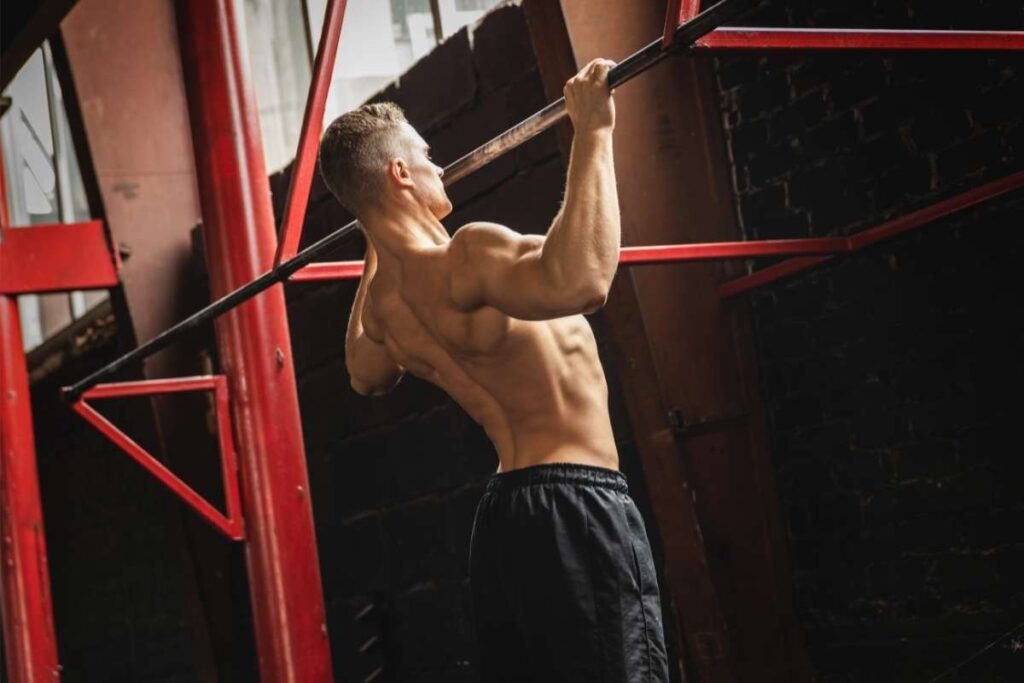
Let’s learn a little bit more the mechanics of vertical pulling exercises, beginning with what they are.
What are vertical pull exercises?
Vertical pull exercises are characterized by pulling resistance from the floor or overhead using a free weight, cables, or body weight.
Examples of these exercises include chin-ups, lat pulldowns, bent-over rows, and deadlifts.
Muscles That Vertical Pull Exercises Work
Which muscles give you a stronger, more aesthetic back? Here’s a list of target muscles you can work with vertical pull movements.
- Latissimus Dorsi
- Rhomboids
- Traps
- Rear Delts
- Biceps
How to Do Vertical Pull Exercises at Home
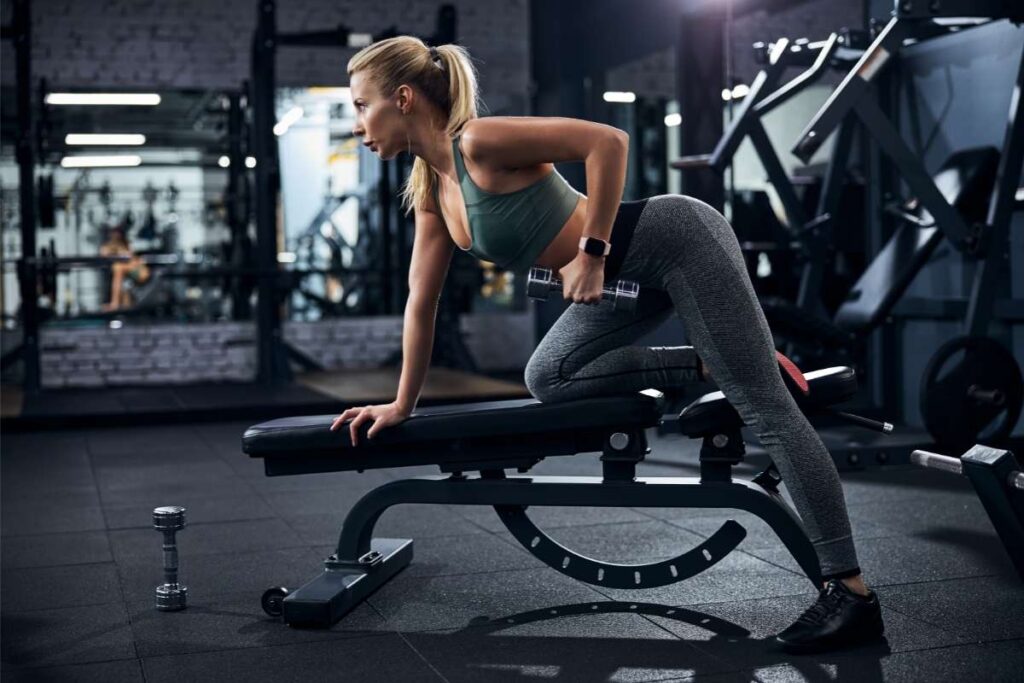
One of the major benefits of vertical pull exercises is that they can be done anywhere.
Below are some examples of vertical pulling exercises that can be performed at home using bodyweight, bands, and dumbbells.
Vertical Pull Exercises – No Equipment
Performing vertical pull movements with no equipment can be difficult. It may require the use of a bar for pull-ups, or a variation of bodyweight resistance.
Making use of bars overhead is great for chin-ups, while outdoor railings at parks or schools can be used for inverted rows.
Vertical Pull Exercises with Bands
Related: 13 Resistance Band Shoulder Exercises
Bands can be anchored under your feet or above your head to provide you with a point of resistance.
From here, you can perform movements such as upright rows, deadlifts, and biceps curls by anchoring at the feet.
And lat pulldown, single arm rows when anchoring overhead.
Vertical Pull Exercises with Dumbbells
Dumbbells and free weights have been a staple for vertical pull exercises for decades. By simply lifting the weight directly off the floor, you’re engaging in a vertical pull exercise.
Movements such as barbell rows, deadlifts, and dumbbell single-arm rows are all forms of vertical pull exercises.
Vertical Pull vs. Horizontal Pull Exercises
The difference between vertical pull and horizontal pull exercises is the point of resistance.
As we covered, vertical pull movements can be performed with bands, free weights, cables, and bodyweight. Horizontal pull movements, meanwhile, are usually cable or machine-based.
One of the main differences here is that vertical pull movements can be performed with a considerable amount of resistance, which at times engages the entire body.
An example is a deadlift.
The deadlift is considered the king of strength exercises, as it requires lifters to vertically pull the dead weight directly off the floor.
In this instance, the barbell can be loaded up with hundreds of kilograms, requiring the entire body to engage.
Horizontal pull exercises, on the other hand, are manufactured resistance using cables or hinges.
When we perform horizontal pull movements we still engage other aspects of the body. However, the weight is comparatively less due to an often seated position.
Want to build a balanced physique? Check out the Ultimate Guide To Horizontal Push Exercises.
10 Best Vertical Pull Exercises
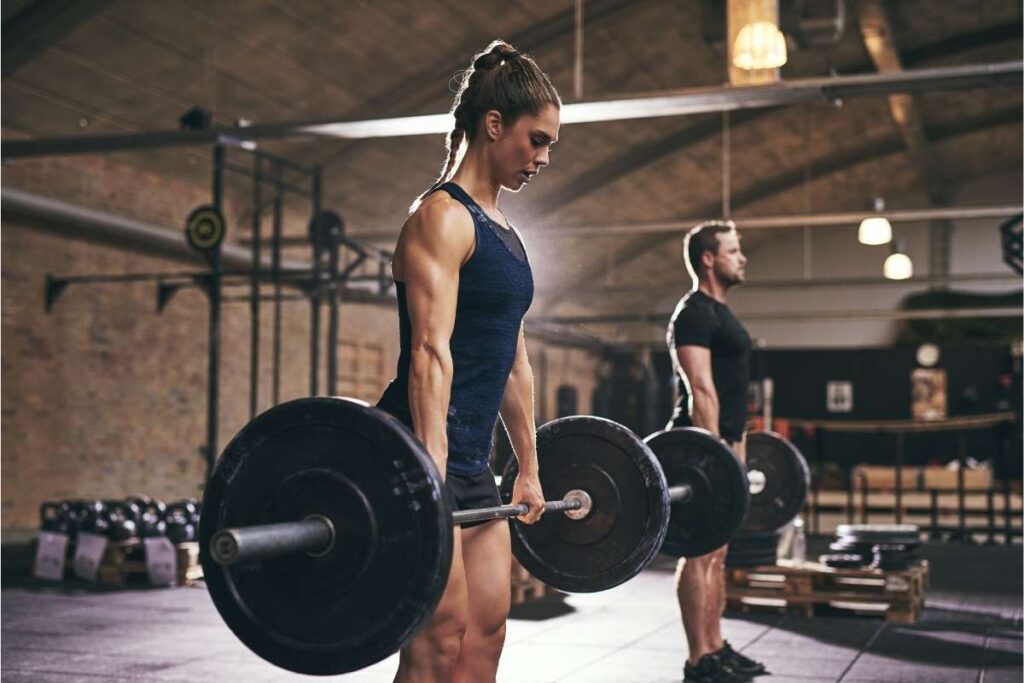
It’s time to get into the basics of a bigger, better back. Here’s a list of the best vertical pulling exercises using all types of equipment, or just body weight.
1. Lat Pulldown
Related: 14 Excellent Lat Alternatives
The lat pulldown is one of the most well-known vertical pull exercises.
It serves as a great upper body foundation movement for beginners, with the ability to be loaded up for advanced lifters. That’s why it’s the perfect exercise for any pull workout.
Equipment Requirements
- Lat Pulldown Machine
How To Perform Lat Pulldown
- Take a seat on the lat pulldown and position your knees under support pads.
- Reach overhead and grab the bar slightly wider than shoulder-width apart.
- Lean back slightly.
- To begin, pull the bar down toward your collarbone.
- Once the bar makes contact with your collarbone, slowly release it back to the starting position. Repeat.
Benefits
- Builds mass
- Increases strength
Pro Tip
- Lean back slightly to allow the bar to pass your chin.
- Focus on squeezing the elbows back when pulling the bar down. This will help you contract the muscle through your back.
2. Banded Lat Pulldown
The banded pulldown allows you to perform the lat pulldown anywhere you can anchor a band overhead.
While the resistance is different from a cable, the band is still a useful piece of equipment for anyone to train away from the gym.
Equipment Requirements
- Band
- Bench
How To Perform Banded Lat Pulldown
- Anchor the band overhead using a squat rack or bar.
- Grab the band with both hands and take a seat on the bench directly below the band.
- To begin, pull the band down toward the chest until the hands are in line with the collarbone.
- Once you reach this position, gently release the band back to the starting position. Repeat.
Benefits
- Can be done anywhere
- Builds mass
Pro Tip
- Focus on breathing, exhaling as you pull and inhaling as you release.
- To maximize contraction, pull down with elbows and squeeze shoulder blades together.
3. Banded Shrugs
The banded shrug is a simple and effective way to build the traps and fill out your upper back.
Equipment Requirements
- Band
How To Perform Banded Shrugs
- Standing, anchor a resistance band under your feet, holding one end of the resistance band in each hand.
- To begin, gently pull the band to increase tension.
- Shrug your shoulders up until they are just below ear level.
- Lower shoulders back to starting position. Repeat.
Benefits
- Increase Mass
- Improve Physique
Pro Tip
- When performing the shrug, focus on squeezing the trap muscle.
- Exhale when you shrug and inhale as you release.
4. Banded Pull-Up
The banded pull-up serves as a great introduction to lifters who want to build up to their first pull-up.
This is great when there is no assisted pull-up machine. You can simply tie a slip knot around the bar and allow the band to assist you by pulling your weight up.
Equipment Requirements
- Band
- Chin-Up Bar
How To Perform Banded Pull-Up
- Standing beneath a pull-up bar, loop the band around the bar directly overhead using a slip knot.
- Loop the bottom of the band under your feet.
- Reach overhead and grab the bar using an overhand grip slightly wider than shoulder-width apart.
- To begin, pull yourself up toward the bar until your collarbone makes contact with the bar.
- Once at the top, release back to the starting position. Repeat.
Benefits
- Helps to build to pull-up
- Increases mass
Pro Tip
- Keep your legs straight. This will help keep your body rigid and provide a base for the resistance to assist your pull-up.
- When pulling up, focus on squeezing your elbows back. This will help you contract your back.
5. Inverted Row
The inverted row is a great introduction to bodyweight pull movements for beginners.
It allows you to perform a bodyweight vertical pull movement with the comfort of having your feet on the ground.
Equipment Requirements
- Squat Rack
- Barbell
How To Perform Inverted Row
- Take a seat on the floor with legs out straight.
- Position yourself directly under the squat rack with the barbell set up just above head height.
- Reach overhead and grab the barbell slightly wider than shoulder-width apart.
- Lift your hips up off the floor so your weight is held by your arms and rests in your heels.
- To begin, gently pull squeeze shoulder blades together and row your chest toward the bar.
- Row until your chest makes contact with the bar.
- Once at the top, slowly lower until your arms are outstretched. Repeat.
Benefits
- Introduces body-weight pull mechanics
- It can be adjusted to suit the experience level
Pro Tip
- Aim to keep your hips up so that your legs and torso are in alignment. This will keep your core activated and improve your ability to lift your body weight.
- Focus on your breathing, exhaling and tensing your core as you pull yourself up to the bar. This will help improve stability.
6. Chin-Up
The chin-up is considered one of the best bodyweight exercises for developing the back.
While the movement is performed using the back and arms, the rest of the body must remain rigid to minimize unnecessary movement.
Equipment Requirements
- Chin-up bar
How To Perform Chin-Up
- Standing directly below a chin-up bar, reach overhead and grab the bar shoulder-width.
- Begin by gently pulling your shoulder blades back down and pulling yourself up to the bar.
- Pull yourself up until the bar meets your collarbone.
- Once you reach this position, slowly release back down to the starting position. Repeat.
Benefits
- Full-body exercise
- Can be almost done anywhere
Pro Tip
- If space permits, aim to have your legs straight and in line with the body. This will help you remain rigid and reduce unwanted motion in the body.
- When performing the pull-up, focus on pulling the elbows back. This will help you contract the muscles of the back.
7. Dumbbell Single-Arm Row
The dumbbell single-arm row is an old favorite in the gym and has been used for many years to develop size and strength.
Performing the row one arm at a time gives us the chance to focus on targeting each side individually, which is great for building unilateral strength.
Equipment Requirements
- Dumbbell
- Bench
How To Perform Dumbbell Single-Arm Row
- Standing to one side of the bend, rest your nearest knee on the bench.
- Lean forward and rest the same side hand on the bench so your torso is parallel with the floor.
- Pick up a dumbbell with your free hand.
- To begin, gently pull the shoulder blade back and row it up and back toward the hips.
- Row until the elbow is bent at 90 degrees.
- Once it reaches this position, slowly lower it back to the starting position.
- Complete all repetitions with this side, then switch sides.
Benefits
- Builds unilateral strength
- Increases mass
Pro Tip
- When performing the row, keep the elbow tucked to the side. This will help you squeeze through your back.
- Focus on breathing with each rep. Exhale and engage your core as you lift the dumbbell and inhale as you lower.
8. Barbell Rows
The barbell row is an excellent movement that allows us to load up the weight and push our back to its limits.
The barbell has a huge weight capacity, which is perfect for progressive overloading.
Equipment Requirements
- Barbell
- Weight Plates
How To Perform Barbell Rows
- Standing holding a barbell slightly wider than shoulder-width apart.
- Lean forward at the hips 45 degrees.
- Gently pull your shoulder blades back and row the barbell up towards your body.
- Row until your elbows are bent at 90 degrees.
- Lower the barbell back to the starting position. Repeat.
Benefits
- Increase mass
- Can load up the weight
Pro Tip
- Aim to lean forward at 90 degrees. This will help you hit your target back muscles.
- Focus on breathing and bracing your core for the duration of the movement.
9. Deadlift
Related: A Detailed Guide To Hook Grip Deadlift
The deadlift is the king of all strength exercises and the perfect vertical pull exercise.
With the objective of pulling the weight vertically off the floor in the most efficient way possible, the deadlift is a full-body movement that is great for building strength and mass.
Equipment Requirements
- Barbell/Kettlebell
How To Perform Deadlift
- Standing with a barbell set up in front of you, with the bar directly over the top of your shoelaces
- Place feet shoulder-width apart.
- Unhinge at the hips and bend forward.
- Grab the barbell shoulder-width apart.
- To begin, lower the hips and gently pull the barbell to create tension through the lats.
- Begin to pull the weight vertically, pushing through the legs.
- Once the bar passes the knees, push your hips forward until you reach the upright position.
- From here, unhinge the hips and lower back to the floor. Repeat.
Benefits
- Builds Strength
- Increases Mass
Pro Tip
- Before lifting, gently pull the barbell and pull shoulder blades down toward your hips. This will help create tension in your body.
- Exhale as you lift and inhale as you lower the bar back to the floor.
10. Pendlay Row
The Pendlay row’s bent-over position makes this vertical pull exercise a monster for building strength and size.
Equipment Requirements
- Barbell
- Weight Plate
How To Perform Pendlay Row
- Standing with a barbell set up on the floor in front of you, bend forward at the hips 90 degrees.
- Grab the bar slightly wider than shoulder-width apart.
- To begin, pull your shoulder blades back and row the bar toward your torso.
- Row until your elbows are bent at 90 degrees and lower the bar back to the ground. Repeat.
Benefits
- Build strength
- Increase mass
Pro Tip
- Focus on breathing, exhaling and bracing your core before each rep. Inhale as you lower the bar.
- Following each row, lower the barbell to the floor. This will help you pull greater loads.
The Best Vertical Pull Workout Program
Related: Top 10 Middle Back Exercises
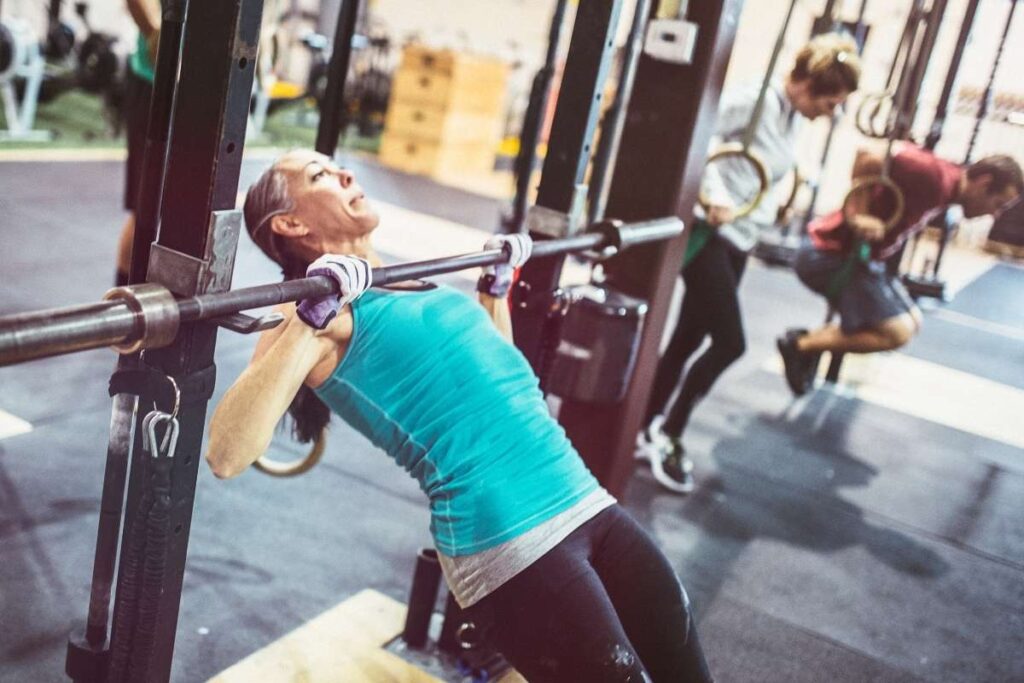
Below are two vertical pull workout programs, one for beginners and one for advanced.
The beginner program is based on an upper/lower split, and the advanced is based on a push, pull, and leg split.
Beginner Weekly Schedule
| Mon | Tues | Wed | Thurs | Fri | Sat | Sun |
| Upper | Lower | Rest | Upper | Lower | Rest | Rest |
Beginners Workout (Duration 40-45 Minutes)
| Exercise | Sets | Reps | Rest |
| Deadlift | 3 | 8-12 | 45-60 secs |
| Banded Pull-Up | 3 | 8-12 | 30-45 secs |
| Lat Pulldown | 3 | 8-10 | 30-45 secs |
| Barbell Row | 3 | 10 | 30-45 secs |
| Inverted Row | 3 | 10 | 30-45 secs |
| Dumbbell Single-Arm Row | 3 | 8-10 | 30-45 secs |
| Banded Shrug | 3 | 8-12 | 30-45 secs |
Advanced Weekly Schedule
| Mon | Tues | Wed | Thurs | Fri | Sat | Sun |
| Push | Pull | Legs | Rest | Push | Pull | Rest |
Advanced Workout (Duration 50-60 Minutes)
| Exercise | Sets | Reps | Rest |
| Deadlift | 4 | 8 | 30-60 secs |
| Chin-Ups | 4 | 8-10 | 30-45 secs |
| Lat Pulldown | 4 | 8-10 | 30-45 secs |
| Pendlay Row | 4 | 6-8 | 30-60 secs |
| Inverted Row | 4 | 8 | 30-45 secs |
| Dumbbell Single-Arm Rows | 4 | 8-10 | 30-45 secs |
Want A shredded V-tapered back? Check out 10 Top Dumbbell Lat Exercises For A ‘V-Taper’ Back.
Tips For Performing Vertical Pull Exercises Effectively
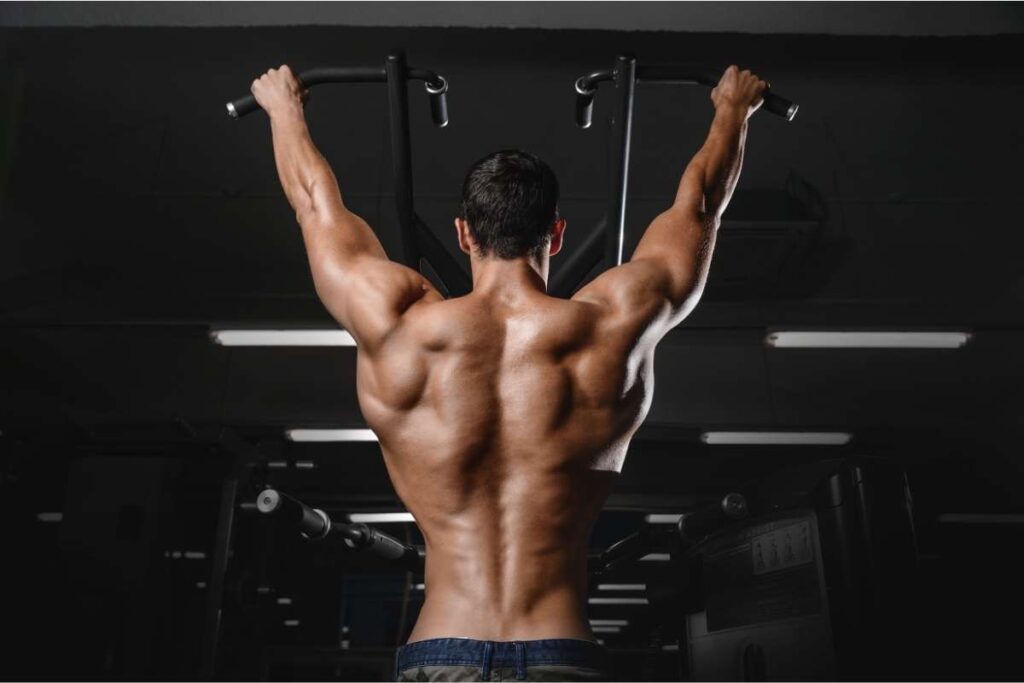
Before you start these workouts, consider my list of tips to help you get the most out of your vertical pull exercises.
Engage Shoulder Blades
Before each repetition, pull the shoulder blades back into position.
This will draw your attention to the target area prior to your lift and improve your ability to activate the target muscle.
Pull Elbows Back
When you perform your lift, focus on pulling your elbows back. This removes your focus from your hand.
Overall, it will help you focus on contracting the target muscles through the back.
Focus on Contraction
When you are performing your vertical pull movement, focus on squeezing target muscles such as lats, rhomboids, and traps.
This will increase your mind-muscle connection, which has been scientifically identified to improve muscle activation.
Start Light
When performing your vertical pull exercises, start light.
This will allow you to focus on your technique, engage shoulder blades, pull back elbows, and contract target muscles.
Once you have your technique and activation down and establish your mind-muscle connection, you can then load up the weight and put your muscle to the test.
Final Thoughts
Well, that almost wraps up the rundown on vertical pulling exercises.
Vertical pull exercises are a brilliant tool for increasing strength and mass as well as improving your physique.
Their ability to improve function through movements such as deadlifts and rows makes them highly beneficial to our daily life.
Just remember to squeeze shoulder blades, pull back elbows, and focus on your target muscles.
Before too long, you’ll build a strong, thick, broad back for a monster physique.
So, what vertical pull exercises are you currently doing? Are you thinking of giving our program a try?
Let me know in the comments below.
What are vertical pull exercises?
Vertical pull exercises are movements where the resistance is pulled in a vertical path.
Movements such as dumbbell and barbell rows, deadlifts, and chin-ups are all forms of vertical pulling exercises.
This is because the path of resistance is directed upward and downward.
What are two exercise examples of a vertical pull?
Two examples of vertical pull exercises are lat pulldown and barbell row.
While the point of resistance is different for each, the vertical up and down motion of the resistance is the same for both exercises.
Is a deadlift a vertical pull exercise?
The deadlift is a vertical pull exercise. When we pull the barbell off the floor, our aim is to lift the weight in the straightest and most vertical bar path possible.
This increases our efficiency and capacity to lift great weights.
What are 6 common pull exercises?
Six common pull exercises found in resistance training are deadlifts, barbell rows, dumbbell rows, chin-ups, lat pulldowns, and shrugs.
Is a shrug a vertical pull?
Yes, the shrug is a vertical pull. While the elbows do not flex during the shrug, the elevation of the scapulas that creates the shrug causes us to pull the resistance upward.
This classifies it as a vertical pull movement.
Is a bicep curl a vertical pull?
Yes, bicep curls are a vertical pull movement. As the point of resistance is the floor due to gravity, we are required to pull the weight vertically to contract the bicep.
Are vertical pulls necessary?
No, vertical pulls are not necessary. However, they are an incredible tool for not only building muscle but improving function.
For many, lifting directly up off the floor is a common movement.
Training your muscles to vertically pull can be beneficial for improving the function surrounding these movements.

